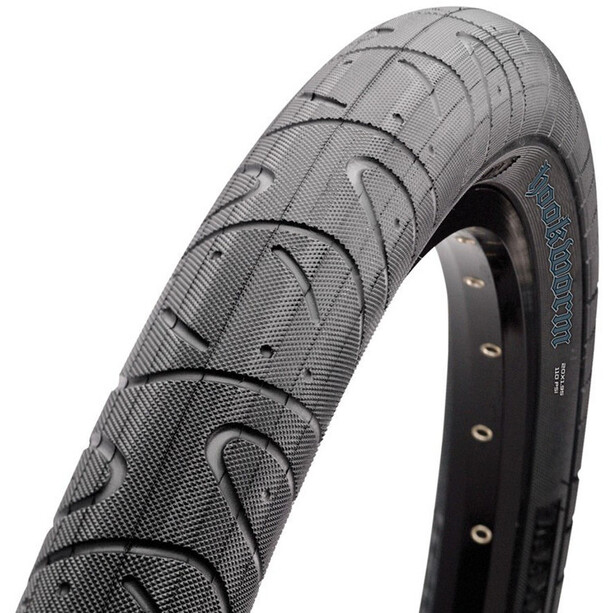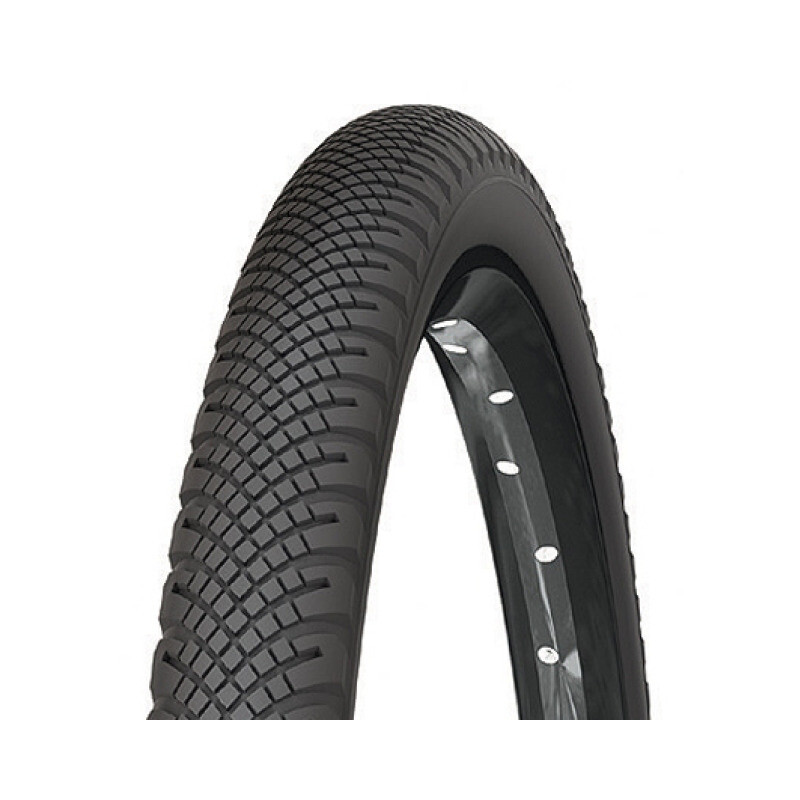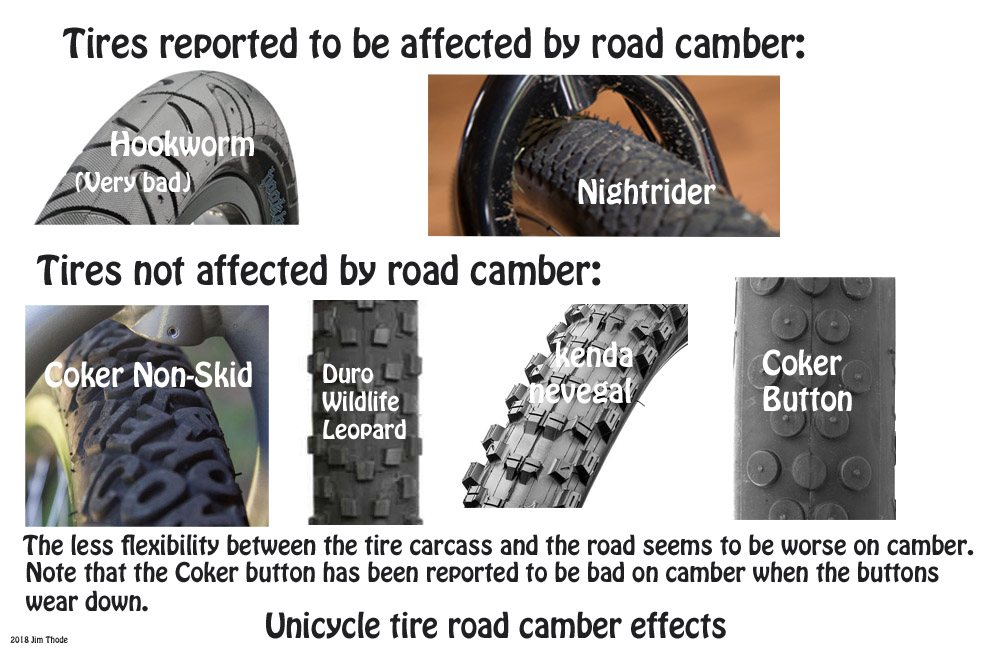So, an issue that I seem to fight when I ride on bike trails and roads is that I tilt to one side, this is especially true on roads with a nasty camber. It is not that I am new to unicycling, or not that new. I have for instance put 1500km of riding on my latest wheel which I built about 2 years ago. I have tried a few different tires on this uni, including 27.5 inch tires (such as a Hans Dampf) before I put my Magura brake on. The current tire that I have on it is a Kenda Nevegal 2.5" I believe. So what I was wondering if a rounder profile tire would be more suitable for me to iron out my tilt to the side. I wanted to do a ride your age in km this year, but only managed 40km (I was shooting for 58). I just wore myself out on some of the cambered surfaces; it felt like I was struggling to ride. Sigh. Any advice is welcome. Oh, one other thing, I was in Toronto one week in the Summer and a friend lent me his 24" unicycle with a 3" wide round profile tire. We rode together and I had absolutely no tilting to the side with that. I suppose that is why I am wondering if a more rounded profile tire will help me when the roads are more cambered? Thanks in advance for any advice.
What size cranks are you pedaling?
It makes a big difference for “asymetrical” pedaling output.
When you are on a tilt, crown road you need more pedal pressure on one side.
At the same time, this uneven pedaling will affect your balance.
Much easier to control with longer cranks than shorty cranks.
Great question @slamdance. I am using 145mm cranks at this stage. I tried some 110’s at one point, but I found it a bit hard to go up some hills with them. On my 20" I have 137mm cranks. I don’t think I list to one side on it, but again it has a more rounded profile tire, I think it is called a Creepy Crawler and is 3" wide. However, I don’t try to go any great distances on the small uni, I just thought I’d use it for improving / learning skills like idling, backwards riding, hopping, etc.
I’ll chime in here for a moment.
Maxxis Hookworm 26x 2.50
You probably mean this tire. I drove it before and it was nice to take corners with.
But you have to be careful with statements. The driving behavior can change depending on the rim width. I just had this experience with my Fatty unicycle.
It’s a book with seven seals as to what kind of tire is suitable for riding a unicycle.
Following the argument of a round profile, I bought the Michelin Country Rock. Visually it seems perfect for unicycling. However, I was very disappointed. He wasn’t good at driving.
There seem to be many factors such as tire width, profile, condition of the casing, shape of the tire.
As a dealer, I always tested the tires before I bought them. There were many that were useless.
26 inch: Here the selection has unfortunately become smaller due to the 27.5".
At the moment I’m driving the Surly Dirt Wizard on my 26" due to the weather. It’s somewhere in the middle in terms of steerability and handling. In the summer the Vee T-Fatty 26x 3.0 which is a lot worse on sloping roads.
The best tire I ever drove was a Vee Tire 26x 2.50, I don’t remember the name, but I could pass it on later. It was simply perfect on a side slope.
Otherwise, I remember the Continental Rubber Queen (today it’s called Trail King) 26x 2.40 - it’s available in different qualities and also the Schwalbe Rapid Rob 26x 2.25. They have good driving characteristics.
At 27.5", I remember the Schwalbe Rocket Ron 27.5x 3.0 and Nobby Nic 27.5x 3.0 with good driving characteristics. Unfortunately, I can’t judge how the 26x 2.40 versions of them drive.
Although you may not always have an option, riding on surfaces with less friction like wet or icy pavement or dirt or gravel have a less of a camber affect. Higher tire pressures also help reduce the affect of camber.
This is my take on tires:
The Hookworm 26 inch is probably the worst tyre ever on a road unicycle. Seriously affected by camber, poor grip in the wet on smooth surfaces and crazy heavy. It is a great tyre on a 20 inch where the momentum is an advantage and camber sensitivity is not evident.
The main factor in reducing camber sensitivity is the decoupling of the camber thrust from the wheel. This can be done by reducing the tread grip on the road with knobbly tyre which allows the grip to be released as the contact moves from one knob to the next.
The other way is to choose a tyre with very flexible sidewalls, which limits how much camber thrust is fed to the wheel. The Hookworm is terrible for camber thrust because it has neither of these factors.
My road 26 has a Maxxis DTH 26 x 2.3. It has good traction and very flexible sidewalls. It is literally half the weight of the Hookworm. However it is no a high mileage tyre.
from @www.einradshop.ch : “It’s a book with seven seals as to what kind of tire is suitable for riding a unicycle.”
OK let’s think about opening those seals (in order) …
SEAL 1: what sort of road surface? if it is not paved with a cambered surface, we do not need to proceed any further.
SEAL 2: what diameter wheel? we cannot make valid comparisons without knowing this, so onwards…
SEAL 3: rim width? this has to be INNER width (some dominator2 rims have an outer width of 42 but an inner width of 33mm, some QU-AX rims have an inner width of 38.6mm) …
SEAL 4: tire width? (hmm a bit of a semi-arbitrary “nominal” figure, sadly) …
SEAL 5: desired “ride softness”? - determined by tire pressure, in relation to rider and unicycle weight, and (hard to determine) tire construction…
SEAL 6: tire shape? (when fitted and being ridden) - getting a bit more subjective - “round” or “squarish” or “almost V shaped” …
SEAL 7: tire flexibility when at an angle (its grip on the road, and the shape and length of its “footprint” and the tread pattern (a hard one, but it IS the seventh seal!)
So, without all that, we cannot compare tires.
Is a hookworm tire good or terrible - who knows?
The devil is in the details.
BUT we have been warned - when the seventh seal is broken, we will have plagues, seas and rivers will turn to blood and eventually dry up, we will be scorched by the sun, and the whole world will be destroyed by earthquakes, huge hailstones will fall, and the Earth will eventually become dark (or something like that, so heed the warnings!).
thanks for your comments. I appreciate the time you take to help out unicyclists even if I don’t live in Switzerland.
Thanks this seems at odds with what @www.einradshop.ch had to say, and as I have been using a Kenda Nevagal which you say is not affected by road camber … hmm. Maybe I need to unlearn and learn something in my unicycle riding technique then?
Thanks. Your advice also seems opposite to that of @www.einradshop.ch. Your arguement about the diameter of the tire seems to go along with my experience too, like the 24" that I rode, and the 20" that I also have in my own arsenal of unicycles. Thanks for your comments.
And now thanks for the 7 seals approach to explaining camber. So, the whelle that I build for this unicycle is from a rim that has nothing to do with QU-AX other than I build the wheel for my QU-AX frame. It is a steel rim from a dutch bicycle. This rim was the widest one hanging in my garage … I do a lot of bicycle repair type things (ooh ooh did I say a forbidden word on this forum?). Through this discussion though I think that if I build a wheel using a narrower aluminum rim that might make the tire that sits on it have a rounder profile.
Someone is probably trying to make fun of me. Then just do it ![]() I don’t care. But I can guarantee you one thing: there are a lot of illogical things about riding a unicycle. You can buy a tire that seems to be perfect and has everything it takes to be a good tire. Or you buy a tire that you already use in a larger size (e.g. Schwalbe Big Apple 2.0 - 2.35). You install it and it rides terribly. In my over 40 years of unicycling, I’ve experienced a lot and thrown away a lot of tires. That’s why I call it a book with seven seals. It’s quite possible that it might not have the same meaning in English, as I’m translating it from German using Google Translator.
I don’t care. But I can guarantee you one thing: there are a lot of illogical things about riding a unicycle. You can buy a tire that seems to be perfect and has everything it takes to be a good tire. Or you buy a tire that you already use in a larger size (e.g. Schwalbe Big Apple 2.0 - 2.35). You install it and it rides terribly. In my over 40 years of unicycling, I’ve experienced a lot and thrown away a lot of tires. That’s why I call it a book with seven seals. It’s quite possible that it might not have the same meaning in English, as I’m translating it from German using Google Translator.
Strangely enough, I felt the exact opposite about this tire. I rode it on a relatively narrow (90mm) hub and the rim wasn’t that wide, I think 28 - 30mm (outside). It’s been a long time since this tire has been around for ages. What bothered me was the heavy weight. But once I got going, it rolled excellently on tar and I was able to lean into corners at full speed and take steep corners like no other tire. Was there a different version before? I wasn’t the only one who liked this tire.
*No - I’m NOT making fun of you (although some minor fun playing with the “7 seals” from the book of revelations), I pretty much agree with you 100% as far as unicycling stuff is concerned! *
Camber sensitivity issue is nasty and I’ve experienced exactly the same thing on my KH26. It was discussed here:
TL;DR: Hookworm 26 is bad. DTH is good. Higher tyre pressure decreases/eliminates this kind of issue.
That is a good point that tire construction may evolve with time and not with obscure three letters named clearly marketed as today.
But also 2 other things have changed with time: the rim width used (it is getting a lot wider from the regular bike rims days) and expectations also may have changed due to tire selection and progress.
Somebody snarky would theorize that maybe the riding style changed but that is too much in in-the-old-days-I-was-walking-25-miles-barefoot-in-snow territory to be taken seriously ![]() (except in the HCU: @harper conversational uni-verse
(except in the HCU: @harper conversational uni-verse ![]() ).
).
Danke shön für deinen Antworten. Ich lerne Deutsch und ich lerne immer noch Einradfahren!
I too have had problems with sloped surfaces. For example, if the high side is on the left, instinctively, I start to turn left on my uni. I fight that by extending my left shoulder and arm forward, to try and force the uni back straight. So, I end up riding twisted.
My solution is fight the body lean, to ride straight up and keep my left arm glued to my side or even behind me. For riding on uncambered surfaces, I try to have both hands on the saddle handle, to keep balanced. With only one hand on the saddle, I tend to ride slightly crooked because I’m pulling on the saddle.
Sorry for not talking about tires. My main ride is a 28" with 114 cranks and a wormy tire.
Thanks, I was fishing for anything wheel size, technique whatever. So I haven’t been riding a lot right now as it is icy on the roads. I don’t mind riding unicycle in snow, but lots of ice is not so fun (I could get studs in the tire I suppose, but every onece in a while when I am listing to one side (or the other) the tire treads scrape on my leg … I think that the studs wouldn’t feel so great rubbing on my leg.
So, my son had given me some advice like yours, which amounts to using the upper body rather than the arms so much to provide adjustments to balance. I have a longish touring handle and I am very comfortable riding with my left hand on it. My son suggested I work on two handed riding … but I haven’t done too much with that yet. Now, several days ago I put a longer brake hose on my (hydraulic) magura brakes. This allowed me two things: 1) to get my brake handle further towards the front of my unicycle touring handle 2) to be able to raise my saddle height - before I lengthened the hose I was a little restricted with what height I could raise my saddle to.
That last part, although I didn’t ride very far, might actually help my riding in that I didn’t find myself listing at all. It felt very natural riding … now I didn’t ride very far due to icy conditions. I’ll take my uni out for a longer ride and just walk over icy parts and see how that goes.
So, the wheel size I wondered about too. I wondered what a 36" would be like. Would it amplify any riding technique problems, or smooth over them a bit. Again, I guess tire pressure, tire width, and internal rim width are all part of the equation like others have said. Oh, yes and the kind of tire as well.
Thanks for your response


